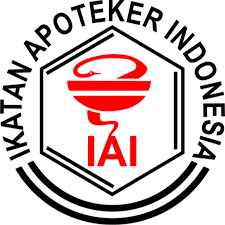Potensi Ekstrak Etanol dan Fraksi-Fraksinya Dari Tiga Varietas Jahe Sebagai Agen Antibakteri Terhadap Staphylococcus aureus
Dewi Dianasari(1*), Endah Puspitasari(2), Indah Yulia Ningsih(3), Bawon Triatmoko(4), Fauzia Ken Nasititi(5)(1) Fakultas Farmasi Universitas Jember
(2) Fakultas Farmasi Universitas Jember
(3) Fakultas Farmasi Universitas Jember
(4) Fakultas Farmasi Universitas Jember
(5) Fakultas Farmasi Universitas Jember
(*) Corresponding Author
Abstract
One of the natural ingredients that to be used to inhibit bacterial growth is the Zingiber officinale. In Indonesia, there are 3 types of ginger which are distinguished by morphology, namely ‘emprit ginger (Zingiber officinale var. Amarum), ‘ gajah’ ginger (Zingiber officinale var. Officinarum), and red ginger (Zingiber officinale var. Rubrum). This research was conducted to determine the activity of extracts and fractions of three ginger varieties in inhibiting the growth of Staphylococcus aureus using the disc diffusion method. The test group consisted of ethanol extract, n-hexane fraction, and ethyl acetate fraction from 3 ginger varieties, concentrations of 5, 10, 20% w / v, gentamicin 10 μg (positive control) and 10% DMSO (negative control). The test results showed that ethanol extracts and fractions from the rhizomes of three varieties of ginger have the ability to inhibit S. aureus at concentrations of 5, 10, and 20% w / v, increasing the concentration will increase the diameter of the inhibition zone. At a concentration of 20% of all samples, the one with the greatest resistance was the n-hexane fraction (diameter of inhibitory zone of emprit ginger 9.80 mm, elephant ginger 9.78 mm, and red ginger 9.90 mm). The difference in ginger variety only affects the antibacterial activity of the ethanol extract, but not the n-hexane and ethyl acetate fractions.
Keywords
Full Text:
PDFReferences
Ajayi A.O. and Omomagiowawi I.E. 2014.Antimicrobial activities and phytochemical analysis of Zingiber officinale (Ginger) on Staphylococcus aureus and Streptococcus species. MITTEILUNGEN KLOSTERNEUBURG. Vol. 64: 1-17.
Chmit, M., Kanaan, H., Habib, J., Abbas, M., Mcheik, A., Chokr, A. 2014. Antibacterial and antibiofilm, activities of polysaccharides, essentiali oil, and fatty oil extracted from Laurus nobilis growing in Lebanon. Asean Pasific Journal of Tropical Medicine. 546-552.
Daryono, E.D.. 2009. Minyak Oleoresin dari Jahe Menggunakan Proses Ekstraksi dengan Pelarut Etanol. “Ekstrak” Jurnal Fundamental dan Aplikasi Teknik Kimia. Vol. 4 (3): 105-109.
El-Baroty GS, El-Baky HHA, Farag RS, Saleh MA. 2010. Characterization of antioxidant and antimicrobial compounds of cinnamon and ginger essential oils. Afr J Bio Res 4(6): 167-174.
Mishra, A. K., P. Yadav, dan A. Mishra. 2016. A systemic review on staphylococcal scalded skin syndrome (ssss): a rare and critical disease of neonates. The Open Microbiology Journal. 10(1):150–159.
Novaldi, Prismawiryanti, Hardi,J., Hardi, Y. 2019. Mikroenkapsulasi Ekstrak Ampas Jahe Merah Dari Hasil Pemisahan Minyak Jahe Merah. KOVALEN:Jurnal Riset Kimia. Vol. 5(1): 17-23.
Nurjanah, S dan Fathia, S. 2017. Aktivitas Antimikroba Ekstrak Jahe Kering Beku Terhadap Beberapa Bakteri Patogen. Jurnal Mutu Pangan Vol. 4(1): 8-15.
Purbaya, S., Aisyah, LS., Jasmansyah, Arianti, W E. 2018. Aktivitas Antibakteri Ekstrak Etil Asetat Jahe Merah (Zingiber officinale Roscoe var. sunti) Terhadap Bakteri Staphylococcus aureus dan Escherichia coli. Jurnal kartika Kimia. 1 (1):29-34.
Purwantoro, R.S., Hartutiningsih-M. Siregar, Sudarmono dan Praptiwi 2010. Uji Antibakteri Lasianthus Sebagai Tumbuhan Berkhasiat Obat Dan Upaya Perbanyakannya. Buletin Kebun Raya. 13(2): 86-93.
Rambiko, S.C., Fatimawali., dan Widdhi B., 2016, Uji Sensitivitas Bakteri Penyebab Infeksi Nosokomial Saluran Kemih Akibat Penggunaan Kateter Terhadap Antibiotik Ampicillin, Amoxicillin dan Ciprofloxacin Di RSUP Prof. Dr. R.D Kandou Manado, Pharmacon Jurnal Ilmiah Farmasi, Vol. 5 (1).
Romero, J.C.L., Rios, H. G., Borges, A., Simoes, M. 2015. Antibacterial Effects and Mode of Action of Selected Essential Oils Components against Escherichia coli and Staphylococcus aureus. Evidence-Based Complementary and Alternative Medicine.Vol. 2015.
Sari, K., Periadnadi dan Nasril Nasir. 2013. Uji Antimikroba Ekstrak Segar JaheJahean (Zingiberaceae) Terhadap Staphylococcus aureus, Escherichia coli dan Candida albicans. Jurnal Biologi Universitas Andalas.
Setyawan A. D., Wiryanto, Suranto, Bermawie, N.2014. Variation in isozymic pattern of germplasm from three of ginger (Zingiber officinale) varieties. Nusantara Bioscience. 6(1):86- 93.
Susihono, W., 2011. Kualitas Rendemen Jahe Asal Indonesia Sebagai Dasar KelayakanJual Ginger Oil Pada Pasar International. Widyariset. Vol. 14 (3): 579-588.
Munda, S., Dutta, S., Haldar,S., dan Lal, M .2018. Chemical Analysis and Therapeutic Uses of Ginger (Zingiber officinale Rosc.) Essential Oil: A Review. Journal of Essential Oil Bearing Plants.Vol. 21(4): 994-1002.
Winata, L. C. W. P. 2011. Uji Aktivitas Antimikroba Ekstrak Etanol Herba Benalu Mangga (Dendrophthoe petandra L. Miq.) Terhadap Bakteri Staphylococcus aureus ATCC 6538 Dan Escherichia coli ATCC 11229 Secara Invitro. http://eprints.ums.ac.id/14883/ [Diakses pada December 23, 2019].
Xie, Y., Yang, W., Tang, F., Chen, X., dan Ren, L. 2015. Antibacterial Activities of Flavonids: Structure-Activity Relationship and Mechanism. Curr Med Chem. Vol. 22(1):132-49.
Article Metrics
Abstract view(s): 1843 time(s)PDF: 2678 time(s)
Refbacks
- There are currently no refbacks.








